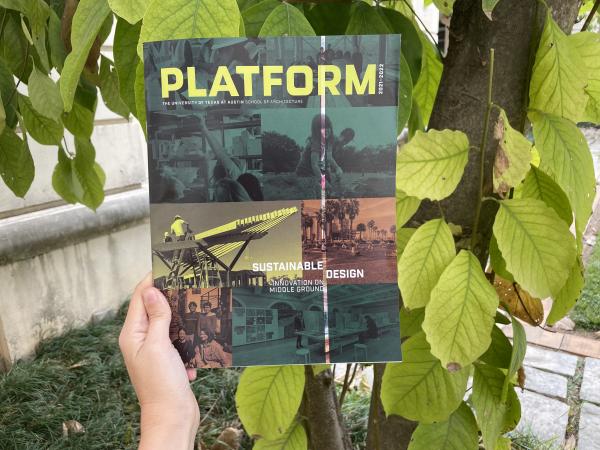2021-22 Issue of PLATFORM Explores Sustainable Design in the Spaces Between Disciplines, Dichotomies, and Practices

As communities around the world increasingly grapple with the physical effects of our changing climate, and the disciplines of the built environment adapt to address current and future challenges, The University of Texas at Austin School of Architecture's 2021-2022 issue of PLATFORM explores the importance of rethinking disciplinary boundaries, embracing complexity, and navigating the spaces in-between as we work to create a more sustainable, resilient and equitable future.
Edited by Associate Professor Matt Fajkus, Sustainable Design—Innovation on Middle Ground features scholarship from across the School of Architecture that advances more sustainable buildings, landscapes, communities, and cities. With writings that span from global and regional scales to material technologies and beyond, each essay presents examples of how faculty and students navigate the middle ground of perceived dichotomies in our fields. Example relationships that call for such alignment and balance include those between city and nature, local and global, present and future, lessons of precedent and needs for invention, and responsibilities to clients and society.
“While sustainable design exists as a distinct program within our school, the larger impact acts more as an ethos that threads through all programs and the very foundation of the school’s ecosystem,” said Fajkus, who also leads the Graduate Program in Sustainable Design. “At its essence, it can be argued that sustainability is not only about work that explores multiple topics in both depth and breadth, but also about finding the middle ground between multiple options or perspectives.”
Essays within Sustainable Design—Innovation on Middle Ground frame planning and design through relationships, rather than objects, demonstrating how research methods, critical practices, and teaching at the School of Architecture cuts across professional areas of expertise and expands disciplinary perspectives. Essay titles and authors include:
- “Community-Centered Climate Planning: Addressing Past Inequities by Preparing for New Climate Futures,” by Assistant Professor Katherine Lieberknecht
- “The End of Binary: What Queer Ecology and Queer People Can Teach Us About Doing Better Design and Planning Work,” by Lecturer and alumna Katie Coyne, Environmental Officer and Assistant Director of Watershed Protection at the City of Austin
- “A Research-Practice Partnership to Advance Anti-Racist Green Building, Education, and Practice,” by Assistant Professor Miriam Solis, Abby Randall, Deputy Director, EcoRise; and Will Davies, Ph.D. candidate, UT Austin and Policy and Data Analyst at Breakthrough Central Texas
- “Plants v. Code: Phyto-Performance and Building Regulations,” by Assistant Professor Aleksandra Jaeschke
- “Building Relationship,” by Professor of Practice Coleman Coker
- “Climate Change, Population Growth, and Energy Consumption in Texas,” by Assistant Professor Juliana Felkner
- “The City of Austin Office of Sustainability and the UT Austin School of Architecture: Sustainable Design Between Global and Local Systems,” by Associate Professor Matt Fajkus and Daniel Garcia, Design Architect, MF Architecture
- “Dispelling Misconceptions about (Mass) Timber in the City,” by Associate Professor Ulrich Dangel
- “Material Manifesto,” by Lecturer and Director of the Materials Lab Jen Wong
- “Measuring Sustainability,” by Associate Professor Francisco Gomes
The School of Architecture has a long and storied history regarding questions of the environment and sustainability. In 1965, the school organized the Texas Conference on Our Environmental Crisis, and sustainability has since been integrated into the school in manifold ways, including as one of the fundamental tenets of the Community and Regional Planning program, as the framework for the advanced degrees in Sustainable Design, and as the tone for research from the Center for Sustainable Development. The appointment of Michelle Addington as Dean in 2017—with her expertise on energy systems, advanced materials, and new technology—has also bolstered the school’s presence and performance in sustainable design thinking.
“I came to The University of Texas at Austin School of Architecture four years ago because I believed it was uniquely suited to address difficult and complex questions, most especially surrounding climate change,” said Addington. “With disciplines spanning the full range of the built environment, we know what it takes to step out of our purview and fold in knowledge from far afield. Sustainability is not a problem to be solved with a heroic solution or a mandate, but rather a constant questioning and requestioning as we work through difficult, intractable problems with the hope that with each question we learn something new, and in so doing, cause less harm.”
Leora Visotzky, Managing Director of the Center for American Architecture and Design, served as Managing Editor for Sustainable Design—Innovation on Middle Ground, with students Julia Szeto and Carolina English serving as Assistant Editors. For more information, and to read the full issue online, visit Sustainable Design—Innovation on Middle Ground.

